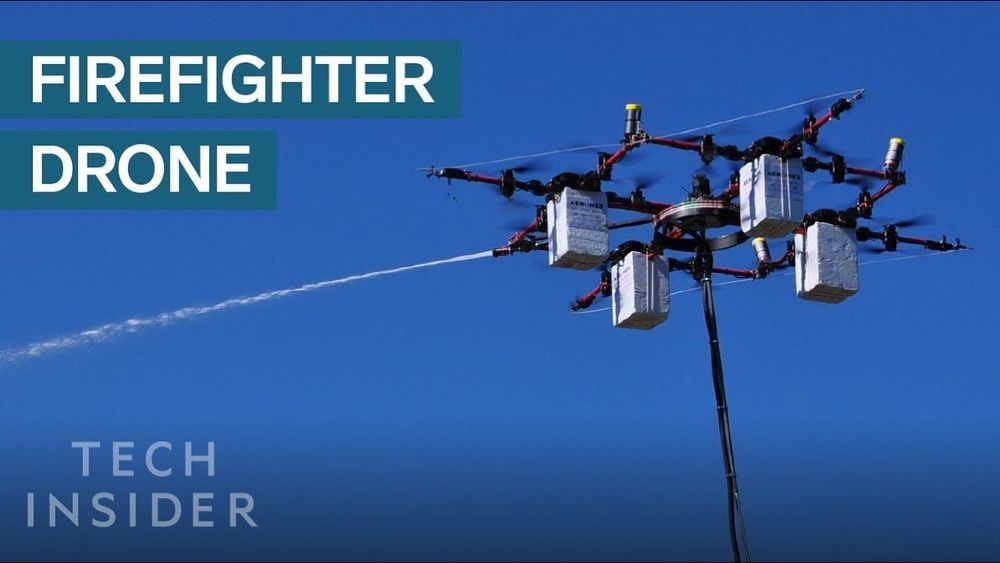Page 8514
May 17, 2019
Drone Could Help Firefighters
Posted by Quinn Sena in categories: drones, entertainment

Latvian company Aerones created the machine, which — according to the company — can fly up to 984 feet, compared to 100-foot-height that firefighter ladders can reach. The drone is fitted with a water hose from a fire truck, and is controlled by a pilot on the ground remotely. However, the drone does suffer from low battery life, providing only 30 minutes flight time from a 90-minute charge. It’s still in development, but Aerones hopes to use the machine for real-life operations soon.
See more from Aerones: https://www.aerones.com/eng/
May 17, 2019
Creating Superhumans Through Gene Manipulation and More
Posted by Quinn Sena in category: futurism
Superhuman powers are rare, but some do exist. But what if scientists used gene manipulation to create humans with super strength and abilities in the future — like super soldiers?
May 17, 2019
Self-repairing batteries: engineers develop a way to create high-capacity long-life batteries
Posted by Quinn Sena in categories: biotech/medical, mobile phones
Engineers at the University of Tokyo continually pioneer new ways to improve battery technology. Professor Atsuo Yamada and his team recently developed a material that can significantly extend the life of batteries and afford them higher capacities, as well.
From smartphones to pacemakers and cars, batteries power much of our world and their importance only continues to grow. There are two particular aspects of batteries that many believe need to improve to meet our future needs. These are the longevity of the battery and also its capacity—how much charge it can store.
The chances are your devices use a type of battery called a lithium-ion battery. But another kind based on sodium rather than lithium may become commonplace soon. Both kinds of battery can store and deliver a large amount of charge, thanks to the way constituent materials pass electrons around. But in both lithium and in sodium batteries, repeated cycles of charging and usage can significantly reduce the storage capacity over time.
May 17, 2019
Darfon’s super-thin Maglev Keyboard will make notebooks even slimmer
Posted by Quinn Sena in category: futurism
May 17, 2019
Triumph Is Building an Electric Motorcycle
Posted by Quinn Sena in categories: sustainability, transportation
May 17, 2019
NASA designed space fabric to make space suits more flexible
Posted by Quinn Sena in categories: 3D printing, space

Raul Polit Casillas at NASA’s JPL created a 3D-printed “space fabric” that’s flexible, easy to create, and a thermal regulator.
FACEBOOK: https://www.facebook.com/mashable/
TWITTER: https://twitter.com/mashable
INSTAGRAM: https://www.instagram.com/mashable/
May 17, 2019
One Man’s Unlikely Quest to Power the World With Magnets
Posted by Quinn Sena in category: particle physics
Dennis Danzik has invented a whirligig that calls for the suspension of disbelief and the laws of physics. If it works as advertised, it would rank with the harnessing of steam, electricity and the atom.
May 17, 2019
Ionic thrusters could power the ultra-efficient, stealth drones of the future
Posted by Quinn Sena in categories: drones, futurism
Stealth drones and other aircraft of the future could be powered by engines that don’t have any moving parts, can’t be detected by infrared, and are more efficient than what we have today. A new study by MIT researchers demonstrated all of these capacities and more for ionic thrusters and now at least one major aerospace company, Lockheed Martin, has said it’s investigating the technology.
“I think UAVs would be the most likely initial application if [ionic thrusters] work,” said the lead researcher in the study, MIT aerospace professor Steven Barrett, in an email to The Verge. Ionic thrusters for aircraft work by generating a high-voltage electrical field that strips electrons from air molecules, “ionizing” them and pushing them away behind an aircraft as ionic wind, to move the craft forward. Scientists and hobbyists have been tinkering with small, lightweight model planes using these kinds of propulsion systems since the 1960s. The technology uses no moving parts and is almost completely silent. It hasn’t come to full-size planes, though, due to power concerns.
May 17, 2019
Helping robots remember: Hyperdimensional computing theory could change the way AI works
Posted by Quinn Sena in category: robotics/AI

The Houston Astros’ José Altuve steps up to the plate on a 3–2 count, studies the pitcher and the situation, gets the go-ahead from third base, tracks the ball’s release, swings … and gets a single up the middle. Just another trip to the plate for the three-time American League batting champion.
Could a robot get a hit in the same situation? Not likely.















